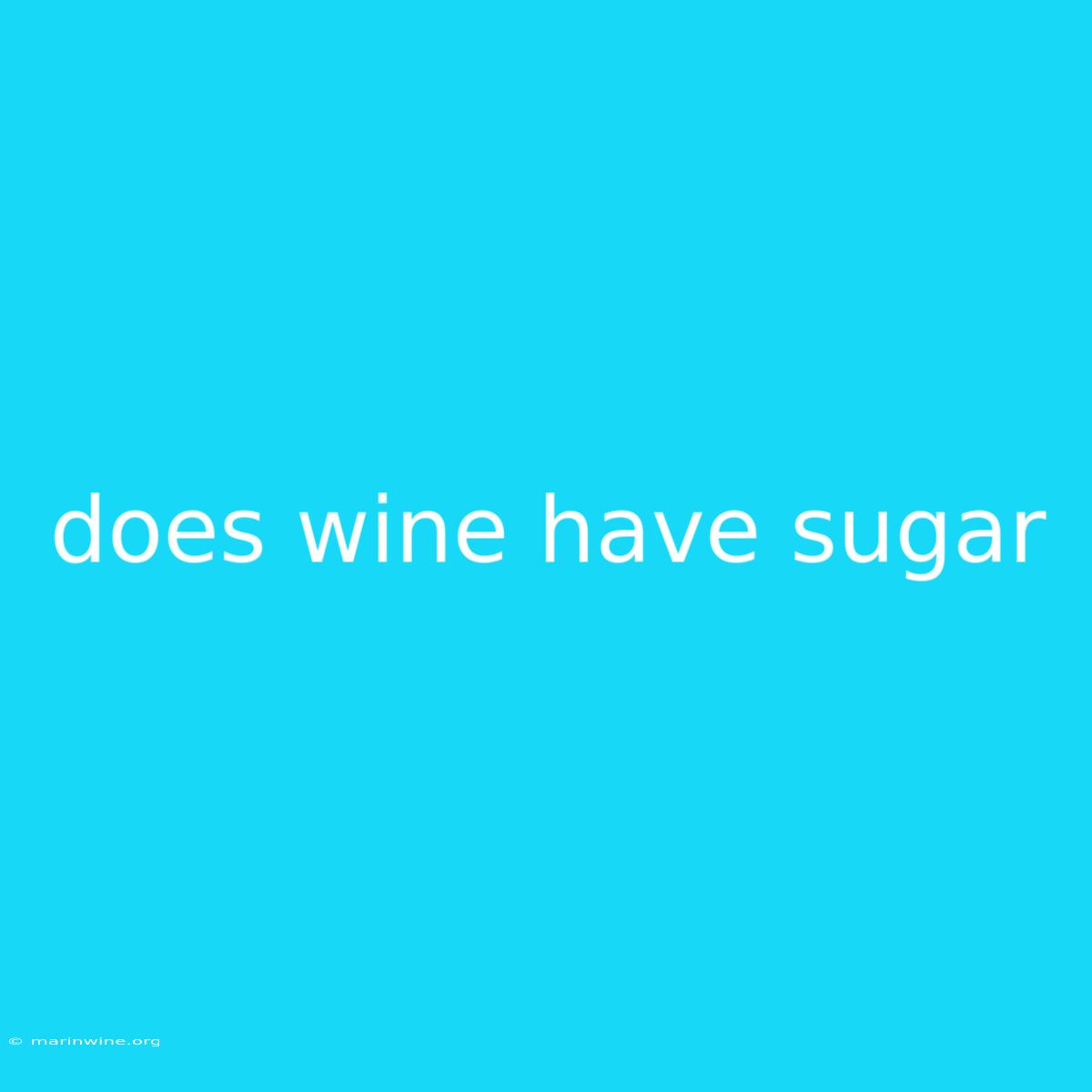Does Wine Have Sugar? Unmasking the Sweet Truth
Does wine have sugar? The answer might surprise you. While many think of wine as a dry, sugar-free beverage, the reality is more nuanced. Wine does contain sugar, but the amount varies significantly depending on the wine's type and production method.
Why It Matters: Understanding the sugar content in wine is crucial for health-conscious individuals, those managing blood sugar levels, and anyone simply seeking a deeper understanding of their favorite beverage.
Key Takeaways of Wine Sugar Content:
| Factor | Impact on Sugar Content |
|---|---|
| Wine Type | Dry wines generally have less sugar than sweet wines. |
| Grape Variety | Some grapes naturally have higher sugar content than others. |
| Production Method | Winemaking techniques, like fermentation and residual sugar levels, influence sugar content. |
Let's delve into the details:
Wine Sugar: A Closer Look
Introduction: The sweetness of wine is determined by the amount of residual sugar left after fermentation. Fermentation is a process where yeast converts sugar into alcohol and carbon dioxide.
Key Aspects:
- Dry Wine: In dry wines, fermentation continues until most of the sugar is converted into alcohol, leaving only a trace amount (typically less than 1 gram per liter) of residual sugar. Dry wines are generally perceived as "not sweet."
- Sweet Wine: Sweet wines have a higher amount of residual sugar. This sugar can come from stopping fermentation early, adding sugar after fermentation, or using grapes with naturally high sugar content.
- Semi-Dry Wine: These wines fall somewhere in between dry and sweet wines, with a noticeable sweetness but not as pronounced as sweet wines.
Residual Sugar and Wine Types:
Introduction: The level of residual sugar directly impacts the overall sweetness of a wine, and is crucial to understanding the nuances of different wine styles.
Facets:
- Dry Red Wines: Typically, Cabernet Sauvignon, Merlot, Pinot Noir, and Syrah are dry wines, often containing less than 1 gram of sugar per liter.
- Dry White Wines: Sauvignon Blanc, Chardonnay, and Riesling (when produced dry) are often dry wines with low residual sugar levels.
- Sweet Wines: Dessert wines like Sauternes, Ice Wine, and Port are known for their high residual sugar levels, resulting in a noticeable sweetness.
Summary: Understanding residual sugar helps you appreciate the complexity of wines and how different wine types cater to diverse taste preferences.
The Health Implications:
Introduction: For individuals monitoring their sugar intake or managing health conditions like diabetes, understanding the sugar content in wine is essential.
Further Analysis:
- Moderation is Key: Even dry wines contain some residual sugar. Therefore, consuming wine in moderation is crucial for overall health.
- Sugar Alternatives: Some winemakers utilize sugar substitutes, like stevia, to reduce sugar content without compromising taste.
- Wine and Blood Sugar: For individuals with diabetes, consulting with their healthcare provider about the appropriate wine consumption is essential.
Table: Sugar Content in Different Wine Types:
| Wine Type | Residual Sugar (g/L) | Sweetness Level |
|---|---|---|
| Dry Red Wine | < 1 | Not Sweet |
| Dry White Wine | < 1 | Not Sweet |
| Semi-Dry Wine | 1 - 5 | Slightly Sweet |
| Sweet Wine | > 5 | Sweet |
| Dessert Wine | 100+ | Very Sweet |
FAQ about Wine Sugar:
Introduction: Here are some common questions about sugar content in wine:
Questions:
- Does wine have sugar? Yes, wine contains sugar, but the amount varies depending on the wine's type and production method.
- Is red wine healthier than white wine? While red wine boasts antioxidants, both red and white wines contain similar sugar levels.
- How much sugar is in a glass of wine? It depends on the type of wine. Dry wines typically contain less than 1 gram of sugar per liter, while sweet wines have significantly higher amounts.
- Does wine raise blood sugar? Yes, wine can raise blood sugar levels. However, the impact varies depending on individual factors and wine type.
- Is it okay to drink wine if I have diabetes? If you have diabetes, consult with your doctor or registered dietitian to discuss wine consumption.
- How can I find wines with lower sugar content? Look for labels indicating "dry," "extra dry," or "brut" as these typically indicate lower sugar levels.
Summary: These FAQs provide valuable insight into common concerns about wine sugar.
Tips for Enjoying Wine with Awareness:
Introduction: Understanding the sugar content in wine empowers you to enjoy it responsibly.
Tips:
- Choose dry wines: If you're looking for lower sugar options, stick to dry wines like Cabernet Sauvignon, Pinot Noir, Sauvignon Blanc, or dry Riesling.
- Read labels: Pay attention to wine labels that indicate sugar content or sweetness levels.
- Taste before you buy: Tasting wines before purchasing gives you a better understanding of their sweetness.
- Pair with food: Pairing wine with food can balance sweetness and create a harmonious flavor experience.
- Moderate your intake: Regardless of the wine type, moderation is key for health and well-being.
Summary: These tips offer practical strategies for enjoying wine while staying aware of sugar content.
Summary of Wine Sugar:
Summary: This article has explored the presence of sugar in wine, highlighting its impact on different wine types and its health implications. Understanding wine sugar empowers informed choices and responsible consumption.
Closing Message: The world of wine is vast and intricate. By acknowledging the sugar content in wine, we can appreciate its complexity and savor its diverse flavors with mindful awareness.

